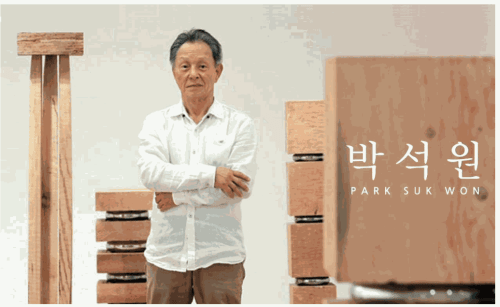Sukwon Park(b. 1942), a visionary of modern Korean abstract artist, is known for his work that gives a strong impression and fresh shock by breaking away from conventional sculpture and painting. In particular, Schorched Earth, the winner of the 1968 National Exhibition, is considered to be Sukwon Park's early masterpiece, which was a sensational sculpture at that time. His understanding and expressing various materials and nature has a lot of influence on Korean art world.
After exploring abstract expression in the early 1960s and minimalism in the 1970s, the artist synthesized the previous works in the 1980s and established an independent world of works. The change in the subject from ‘Scorched Earth’ to ‘Mutation-Relation’ through ‘Accumulation’ implies elements of 'segmentation' and 'conjugation'. Mutation-Relation means stacking, which means cutting or dismantling various materials and then stacking them again. The artist's work of structurally re-accumulating cut objects can be seen as the influence of minimalism, but it also contains a naturalistic interpretation that exposes the texture as it is, unlike artificial and upright minimalism. His work is differentiated from the minimalism of other artificial concepts in that he considers the deformation of matter that occurs in the making process, or even the traces of material left behind, to be the essence of the work.
‘Scorched Earth’ means ‘a state of being devastated and ruined by fire,’ which means ‘blacken soil.’ It is a representative work of modern sculpture that was born with the theme of chaos and tragedy in Korean society after the war. The blighted spaces like the scorched earth, and the traces of tension in which the intense energy of the moment escaped sharply from the original space, express the anger and shock of the time that the artist experienced.
The ‘Mutation-Relation’ is a method of mechanically structuring and accumulating the physical properties of the natural state. The artist's work not only developed into a ‘stacking’ stage of accumulating various sizes of materials.
It's the 1990's ‘Accumulation’ series that extended in the direction of human consciousness of physicality, or the insertion of traces of civilization. Apart from the search for the structure itself by segmentation, it aims to 'humanize' the structure. The substance is cut by pieces and show smooth outline that seems to be flowing. When cutting, follows the artist's own principles and combine to create a space, and explore the essence of the artist's mental world through the process of spatialization. It establishes itself as a representative type of work that the artist is consistently working on through the series up to recently.
The works have a sense of comfort beyond the concept of abstraction, and the extreme naturalness gained by focusing on moderation and simplicity in connoting materials in the structure. It may be because of ‘naturalness’ stemming from his own way of unraveling concepts and thoughts accumulated over 45 years.
Exhibition History
20 Times of Solo Exhibitions / Close to 400 Times of Group Exhibitions
Solo Exhibition
2022 2018 2014 2011 2008 2005 2005 2003 2002 1999 1997 1993 1991 1987 1985 1981 1980 1979 1977 1974
Selected Group Exhibition
Kimsejoong Museum 2018 RHO Gallery, Seoul 2016 Gyeongnam Art Museum, Changwon 2015 Changwon City Masan MoonShin Art Museum 2013 Gana Art Center, Seoul
CUBE Gallery, Seoul 2009 Seoul Art Center Museum, Seoul 2004 Seoul Art Center Museum, Seoul
Gallery RHO, Seoul 2004 Seoul Art Center Museum, Seoul 2003 GAAIN Gallery, Seoul 2000 Total Art Museum, Seoul
Inkong Gallery, Seoul 1995 Batanggol Gallery, Seoul
Duson Gallery, Seoul 1995 Space Art Gallery, Seoul 1986 Muramatsu Gallery, Tokyo, Japan 1984 Space Art Gallery, Seoul
Kyeonji Gallery, Seoul 1983 Myongdong Gallery, Seoul
A walk in modern Korean Art, San Museum, Wonju
Busan Biennale, Busan
Korea - Italy Contemporary Sculpture Exhibition, Milan, ITALY Cheongdo International Sculpture Symposium, Qingdao Sculpture Park, CHINA
The Sunset Sculpture Park Symposium, The Nanji Sculpture Park, Seoul Athens Olympics Commemorative Exhibition of International Modern Art, Athens
Park of Liberty, Athens Art Center, GREECE.
2003 International Art Symposium, Santo Tirso, PORTUGAL Marseille Cultural Fair, Korean Pavilion, FRANCE
Salon 2000, Grands et Jeunes d’Aujourd Hui, Paris Art Museum, FRANCE Korean Contemporary Fine Art Exhibition, Metropolitan Museum of Art, Paris, FRANCE
Triennale Kleinplastik 1995: Europa-Ostasien, GERMANY
Korean Contemporary Fina Art Exhibition, Grand Palais, FRANCE
The Stream of the 70s: Korean Contemporary Fine Art Exhibition, Taipei Museum of Fine Art, CHINA
Aspects of the Korean Contemporary Fine Art Exhibition in the late 70s, Tokyo, Utsunomiya, Sapporo, Osaka, Fukuoka, JAPAN
1983 1983 1982-91
1981-85
1980 1980-81 1975-79
1973 1970-72
1970 1969 1966
‘New Plastic Art” Exhibition, Choonji Gallery, Taipei, China
Korean Contemporary Fine Art Exhibition, Viscontea Hall, Milano, ITALY
A modern Sculpture Exhibition of Korean and Japan, Fukuoka Art Museum, JAPAN, ArtsCenter,TheNationalMuseumofModernandContemporaryArt, Seoul
Korea-Germany Contemporary Art Exhibition, Alexander KOKIG Museum, GERMANY
Asian Contemporary Art Exhibition, Fukuoka Museum of Art, JAPAN
Prints & Drawings, Brooklyn Art Gallery, New York, USA
Ecole de Seoul Exhibition, The National Museum of Modern and Contemporary Art, Seoul
The 1st Sydney Biennale, Sydney Opera House, AUSTRARLA
The Avant-Garde Group Exhibition; The Dynamics of Extension and Resonation, Ministry of Public Information, National Museum of Modern and Contemporary Art, Seoul
EXPO 70, The Special Exhibition of Korean Pavilion, Osaka, JAPAN
The 10th Biennale de Sao Paulo, BRAZIL
The 5th Biennale de Paris, FRANCE
